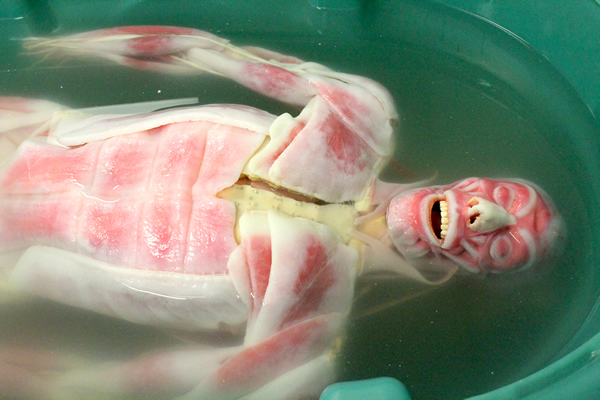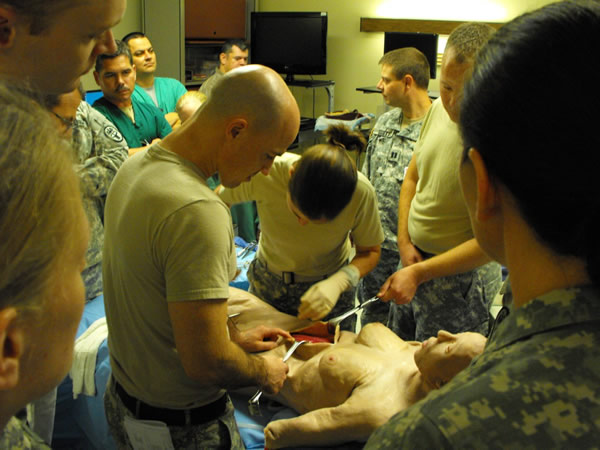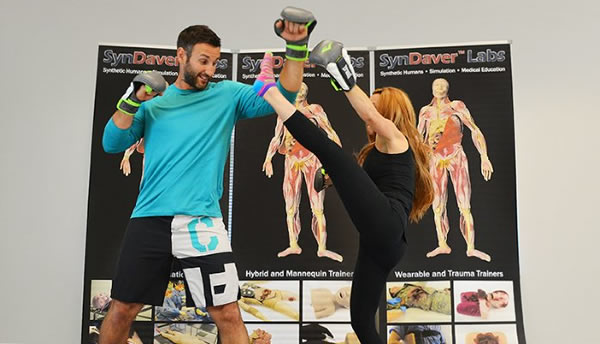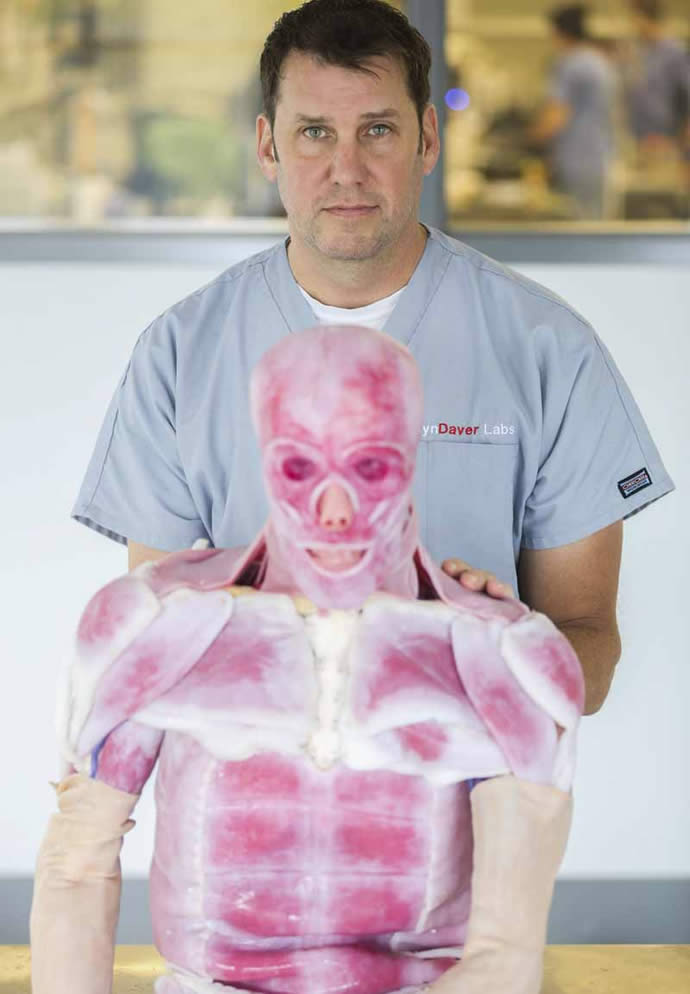If the sight of extremely realistic human body replicas being cut open, poked and prodded for medical training gives you pause, you might just want to come to a complete stop right here.
For the rest of you: Welcome to the world of Syndaver Labs, the Tampa-based maker of synthetic humans for training in schools, hospitals and military installations.
Based in a 35,000-sq.-ft. headquarters and manufacturing complex in Tampa, SynDaver has the world’s largest database of live-tissue properties, but all of SynDaver’s actual tissues are made from water (85 percent), salts, and fibers, blended together in different proportions to yield approximately 100 different tissue types. The company, based on research conducted in the early 1990s at the University of Florida by founder Dr. Chris Sakezles (“sack-you-leez”), has 10 patents on these materials, processes, and related products.
Currently employing more than 100 people, Syndaver has an advanced 5,000-sq.-ft. research facility located in Phoenix, Ariz., and is planning additional small facilities in the US, China, Europe and Latin America for product repair and maintenance.

After all, when it comes to surgical training and device testing, the first cut is the deepest.
“It depends on what you’re doing,” says Sakezles in a phone interview. “Some things are more damaging than others. It’s designed to be cut: If you make a midline incision down the center of the skin, it’s a cut, and it’s going to stay cut until you suture or repair it. This is a $40,000 model. So you need to have the capability nearby to perform that service.”
That’s no problem in the US. But SynDaver has grown global fast. Getting something back and forth to China costs a couple thousand bucks a pop, says Sakezles, “so we really need to have that capability near where our customers are. We want our customers spending the money on product, not on shipping and taxes. That’s not productive.”
SynDaver sells to every Fortune 500 medical device manufacturer, the best hospitals and medical schools, and educational institutions with EMT, nursing, anatomy, mortuary science, surgical technician, physical therapy and sports science programs. Customers range from Nike, GE, P&G, Microsoft and Apple to Beijing Science and Technology University, Harvard and all the major TV networks — the company’s next media appearance will be on CSI.
The global healthcare simulation market is estimated to be worth $2 billion. A SynDaver base model scheduled to be released soon will cost approximately $25,000, while the ultra-high-end Synthetic Human Patient currently retails for around $100,000.
Sakezles says forthcoming locations for those small repair sites will be Boston and San Francisco, with Mexico City and Nanjing, China, next in line. The company’s workspace needs are pretty simple: Class B space is fine, as long as there’s climate control, plumbing and electricity. There’s no heavy-duty machinery, just heavy-duty hand assembly (er, assembly by hand) with small tools.

“What we do is so odd, there’s nowhere to go to find someone that knows how to do it,” Sakezles says. As his firm’s manufacturing footprint follows its sales volume, his team is developing a portable cell or module that can be exported to a given country in order to train the local population.
He says his team does all of its own site reconnaissance, and has yet to receive or ask for any sort of incentives or support from state or regional economic development agencies.
“As we expand and start producing more, our footprint increases pretty rapidly because of the labor intensiveness,” he says. “We’re eventually going to have multiple facilities around the globe — small ones for servicing, and regional sites for manufacturing. Mexico will start out as a servicing center, but turn into a manufacturing center for Latin America.”
By the end of this year, Sakezles anticipates having well over 100 employees in Tampa, a total that he sees reaching several hundred by the end of next year.
“We’re in the process of changing our operations plan to accommodate essentially a tripling of staff,” he says, noting an evolution from an assembly-line approach to a cell-based (modular) layout. “We’re looking for additional space in the area … there are some projections that our space needs are going to go from this to 500,000 square feet over the next few years, which will be impossible to accommodate in a single spot.”
Exposed Parts
Sakezles says his original site selection choice of Tampa wasn’t much of a contest. He was simply coming back to his hometown after leaving Florida to work in the medical device industry. When he came back and started his own company, it was a one-man shop doing contract medical device design work out of the proverbial but very real garage.
“One thing I did was develop anatomical models to test devices on, and this company grew out of that in 2004,” he says. Every product or procedure designed to be used on humans is required by the FDA or the Consumer Product Safety Commission to be proven safe and effective via simulated-use testing. SynDaver’s Synthetic Human, says the company, is an ethical and cost-effective way to get this done.

Sakezles says his company, unlike other medical simulation firms, works from the inside out. “The closest thing you’ve ever seen to our basic material is Jell-O, because it’s solid but almost all water,” he says. “We make our product do what it does because it’s made of a lot of different components. The skeleton, fascia, joints, muscles, ligaments, tendons, all are made separately. Dig down below the surface, and you see systems on systems — each has a layer of complexity on its own. Look at a vein — there are seven different layers to it. Most people build from the outside. We start from the inside and build outward, like an onion.”
While a university was where he formulated his original ideas, university partnerships haven’t proved any more necessary to his growth than economic developers or real estate brokers, with the exception thus far of the University of Arizona’s medical campus in Phoenix, a relationship that came about because of that institution’s very large order for SynDaver products.
The general public has gotten to know Sakezles and his company because of appearances on three episodes of “Mythbusters” and an appearance on episode 625 of “Shark Tank” earlier this year.
“That was my wife’s idea,” he says. “I’ve always been a fan of the show. She said, ‘You should go on this.’ I said, ‘I’m not doing that.’ “
She repeated her pitch for the pitch show the next year. The couple went online, saw that the deadline was one week away, and threw together a pitch video. But it was the complete package that probably turned producers’ heads.
“I also sent one of the bodies that we created, and that’s something you can’t ignore,” Sakezles says. “I’m quite certain that when a crate the size of a coffin shows up with a body in it, you’re going to open that up and look in it.”
The company’s primary benefit from the show was exposure. A proposed $3-million investment from celebrity investor Robert Herjavec, announced in May, has fallen through — but for a good reason, as far as Sakezles is concerned.
“It didn’t go forward because they wanted to replace my CEO,” he says. “I was seen as exclusively a science guy, not business. That’s mostly true, but I’m still not going to give up the company. We’re doing pretty well — we doubled in size last year, and will double this year, so we’re doing all right.”
SynDaver is developing newborn, preemie and pediatric versions of the synthetic human product line. The company is also in the process of developing a surgical canine model that will be offered to police, military, and veterinary customers. Over the next 24 months SynDaver will begin opening new repair facilities in Russia, Europe and Latin America. “We are also planning a repair and manufacturing facility in China via a joint venture with our partner Tellyes Scientific,” says the company’s investor Web page.

Even as it raises money via an offering ending this month, the firm is currently screening potential investors for its next private offering — expected to commence in the second quarter of 2016. The expected raise is $10 million. Though no date has been set, a public offering may take place in 2018.
In the meantime, SynDaver continues to build a culture as unique as its product line. In addition to recently making a free EKG simulator available via the Google Play app store, in June the firm hired Patrick Mazzocco, a 32-year-old Air Force veteran, International Sports Sciences Association certified master trainer and certified Level 1 CrossFit trainer, as its director of health and wellness — or, as the announcement put it, SynDaver’s “first employee who will focus solely on working with real human bodies.”
In the future, SynDaver plans to build an octagon and offer classes in self-defense and mixed-martial arts. Sakezles says the octagon is as much about a new product line as it is MMA.
“We’re essentially working on armor systems as well,” he hints. “We write software now, with electro-mechanical components, crash testing and ballistics, and the octagon is part of that process.”
SynDaver employees can sign up to participate in one 30-minute class during each paid work day. Currently, employees can choose from classes in yoga and therapeutic form, nutrition, cross-training cardio and fitness, and a running club. Fruit and vegetables are distributed to employees every week.
“We want them to be happy, so they’ll stay here, and we’ll spend less time training people,” says Sakezles. “I believe in promoting freedom as much as possible because it fosters creativity. We’re not a normal company, because I’m not all that normal myself.”

